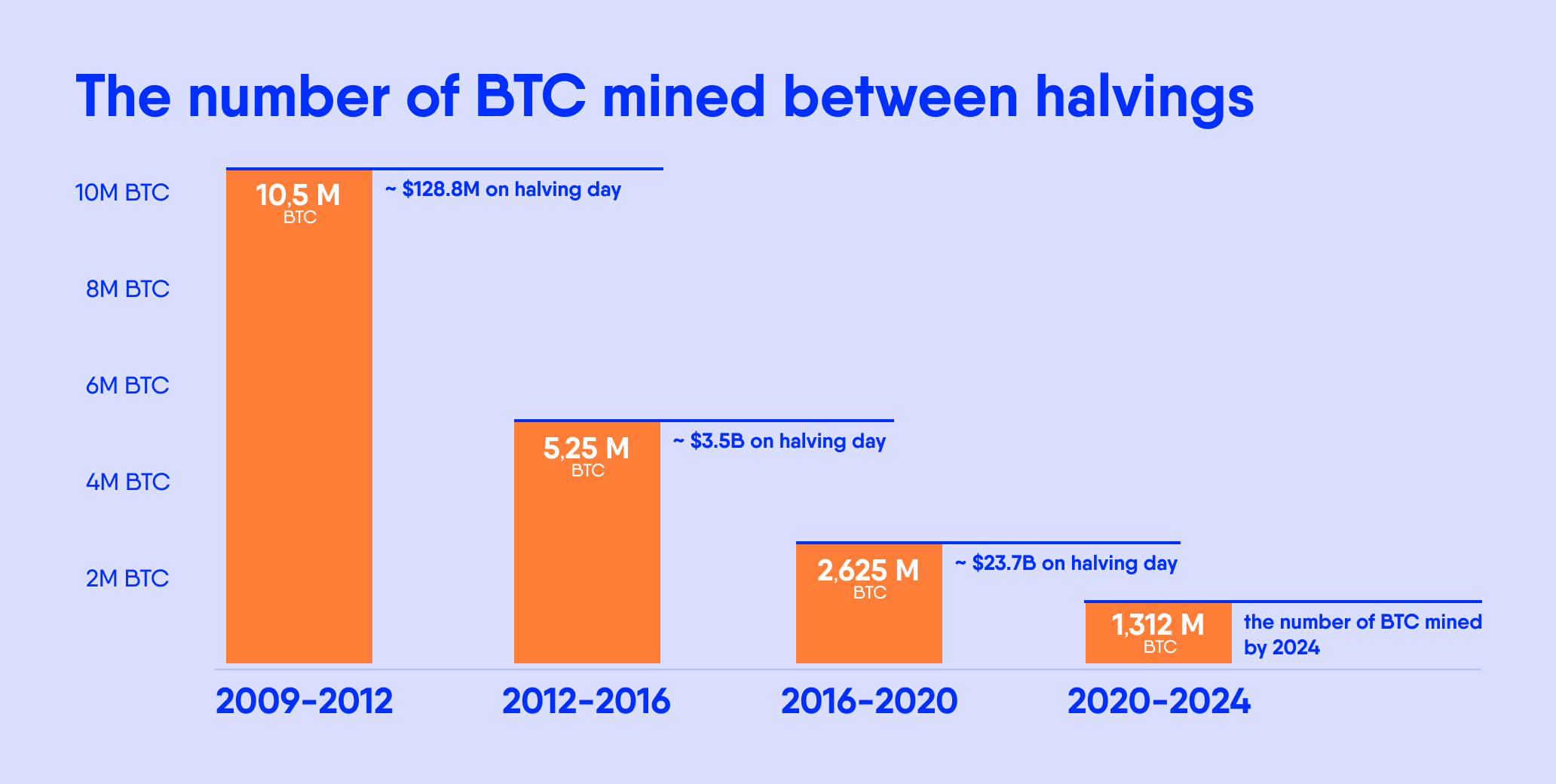 Back to Articles
Back to Articles
What is bitcoin halving and how will it affect BTC’s price?
Roughly, once every four years, the Bitcoin network experiences a halving event. This event impacts the earnings of miners – those who generate new BTC – as well as the network’s inflation rate, issuance speed and the price of the leading cryptocurrency. Discover how halving will influence the crypto market and whether we should expect BTC to reach $100,000 after it.
What is halving?
Halving, programmed by BTC creator Satoshi Nakamoto, means that the reward for mining a new block on the Bitcoin network is cut by half. This decrease of the reward occurs automatically after 210,000 blocks are added which is approximately once every four years.
| 1st halving | 2nd halving | 3rd halving | |
| Date | 28th November 2012 | 9th July 2016 | 11th May 2020 |
| Mining reward decrease | From 50 to 25 BTC per block | From 25 to 12.5 BTC | From 12.5 to 6.25 BTC |
| Price for 1 BTC on the day of halving | $12.27 | $666 | $9,033 |
| Price for 1 BTC one year after halving | $1,077 | $2,635 | ~$55,800 |
The halving’s main goal is to control the emission of the cryptocurrency and curb inflation. In total, 21,000,000 bitcoins can be mined. The last block is expected to be added in 2140.

Its limited supply is the main difference and advantage that Bitcoin has over fiat currencies. For instance, the US Federal Reserve issued more than $3 trillion in 2020 which caused serious concerns from investors. A possible rise in inflation in fiat currencies contributed to Bitcoin attaining the status of a reserve asset in 2020-2021. Analysts at JPMorgan Chase even stated that BTC could become an alternative to gold, and in March 2021 their opinion was confirmed by a Bloomberg report.
Three years after the bitcoin halving
As shown on CoinMarketCap, a year after the third halving, bitcoin has shown steady growth. In November 2020, BTC broke its 2017 price record, reaching $19,749. Since the second half of December 2020, bitcoin has set new records almost daily. This trend continued into 2021 as well. In January, BTC’s price hit $41,900, and on 14th April 2021, the cryptocurrency set a new all-time high at $64,863.
As for Bitcoin’s market cap, during the last year, it’s increased more than six times — from $158 billion to $1 trillion. In terms of market value, the cryptocurrency surpassed giants such as Facebook ($867 billion), Tesla ($605 billion) and Alibaba ($601 billion). Moreover, according to The Block, the number of active bitcoin addresses has increased from 47 to 50 million since the third halving.
Of course, the halving was not the only thing that influenced the BTC price. Among the reasons for its price growth, the following factors can be identified:
- Economic crisis due to the coronavirus pandemic.
- Increased interest from major institutional players in buying BTC, including MicroStrategy, Tesla, Square, Galaxy Digital Holdings, etc.
- Integration of crypto technologies by financial giants such as PayPal, Visa, Mastercard, BNY Mellon, Goldman Sachs, Revolut, etc.
- Greater regulatory certainty regarding cryptocurrencies.
After reaching record highs in the spring of 2021, BTC experienced a sharp drop in the summer, with its price in July falling below $30,000. The first cryptocurrency only recovered by the end of the fall: in November 2021, it rose again above the level of $65,000, but lasted there for a short time. The price decline continued throughout 2022, with BTC dropping to $36,000 in January, $20,500 in June, and below $16,000 in November.
In 2023, BTC rebounded and stabilised between $20,000 and $30,000.
What to expect from the upcoming halving
The next halving is expected in 2024. After block 840,000 is mined, the reward for miners will decrease from 6.25 BTC to 3.12 BTC. Subsequent halvings will occur every four years, halving the reward for mining bitcoins each time.
| Year | Reward for a block | |
| 4th halving | 2024 | 3.12 BTC |
| 5th halving | 2028 | 1.56 BTC |
| 6th halving | 2032 | 0.78 BTC |
| 7th halving | 2036 | 0.39 BTC |
| 8th halving | 2040 | 0.195 BTC |
| 9th halving | 2044 | 0.0975 BTC |
| 10th halving | 2048 | 0.04875 BTC |
What to expect from the fourth bitcoin halving in 2024, how it will affect the coin’s price, and whether BTC will reach the $100,000 mark can be estimated based on data from previous halvings.
Statistics show that each halving event has provided bitcoin with an impulse to reach a new price high, but this impulse gradually diminishes. For instance, after the first halving, BTC grew by almost 10,000%, but after the second, it increased by less than 3,000%, which was 70% lower than the previous result. The price growth of bitcoin after the third “reduction” was less than 700%, also less than after the second.
Taking these data into account, the next price impulse could also be roughly 70% lower than the previous one. Consequently, after the 2024 halving, bitcoin’s price could increase by just over 180%, and it would take about 500 days to reach this mark. Therefore, the next peak might be achieved in September-October 2025 if the halving occurs in April as planned.
Analysts at the asset management company Pantera Capital forecast that the price of bitcoin could reach $149,000 by 2025. However, it’s important to remember that predicting this with absolute certainty is practically impossible. The exchange rate is influenced by numerous other factors, such as sentiment in the stock and cryptocurrency markets, the overall economic situation, the behavior of major players, and so on.